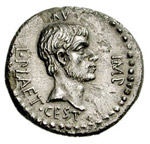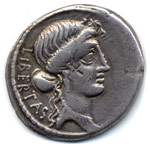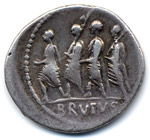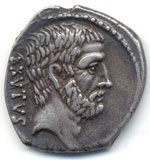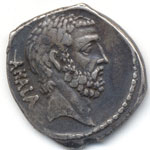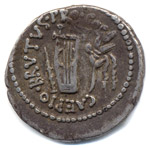Libertas: The Coins of Brutus
RRC 508/3 © CNG 2004
Obverse: Head of Brutus right, bearded; around, BRVT·IMP;
around, L·PLAET·CEST. Border of dots.
Reverse: Pileus between two daggers; below,
EID·MAR. Border of dots.
RRC 433/1
Obverse: Head of Libertas right; behind, LIBERTAS
downwards. Border of dots.
Reverse: L. Iunius Brutus, Cos. 509, walking left,
between two lictors and preceded by an accensus; in exergue,
BRVTVS. Border of dots.
In 44 BC, after the murder of Caesar both Brutus and Cassius (participants in Caesar's death), were forced to flee Italy. Cassius Dio (47.21.2) records that Cassius went to Syria, while Brutus went to Greece and Macedonia. While on the move, each struck a large number of coins emphasising libertas and victory. Most famous of all these is the coin (RRC 508/3) struck by Brutus commemorating Caesar's death, with the reverse displaying a pileus between two daggers and the legend EID MAR (the ides of March, referring to the date of the assassination). The pileus was worn by freedman after they had been set free, and so placing it on a coin was a powerful reminder of the rhetoric surrounding Caesar's death and the republican cause. The imagery was not lost on those in the ancient world: Dio (47.25.1) records that "Brutus stamped upon the coins which were being minted his own likeness and a cap and two daggers, indicating by this and by the inscription that he and Cassius had liberated the fatherland."
The family of the Bruti had a connection with libertas stretching right back to the beginnings of Rome, which Cicero often emphasised in his speeches (e.g. Cicero ad Att ii.24.2-3). The gens were famous for their murder of tyrant kings at the beginning of Rome's history. Before Caesar's assassination, Brutus had emphasised this family heritage while a moneyer. The precise date he held this office is in dispute. Crawford (1974: 455-456) argued for 54 BC, while more recently dates of 55 or 59 BC have been suggested (Cerutti 1993/4). On one of Brutus' coin types (RRC 433/1) displays the head of Libertas, while the reverse shows Brutus' ancestor L. Iunius Brutus as consul, preceded by two lectors and an accensus (aide). L. Iunius Brutus, according to Roman legend, drove the Tarquin kings from Rome and became the first consul in 509 BC after correctly interpreting an oracle from Delphi (Cicero, Brutus 53). Another type (RRC 433/2) minted by Brutus displays his ancestor C. Servilius Ahala, who killed Sp. Maelius in 439 BC when he was aiming at the monarchy.
Brutus' coin types while moneyer have been linked to a growing concern over Pompey's rising power during this period. Pompey had been forced to employ large-scale bribery and corruption in 53 BC to become consul, and violence was increasing in this period. Cicero wrote that at this time "a dictatorship is in the air" (Cicero ad Att 4.18). There is however no concrete evidence that these coins were intended to check Pompey's growing power. Many republican moneyers displayed their family heritage according to the concepts of monumentalitas (Cheung 1998, Meadows & Williams 2001) and there is nothing on these coins to suggest otherwise. Brutus' coins, however, illustrate the historical connection of the Bruti with the defence of libertas and tyrannicide. Brutus' participation in the murder of Caesar was thus imbued with a sense of familial tradition.
Brutus also struck coins after Caesar's death, now in conjunction Cassius, emphasising libertas and Victory. (RRC 498/1, 500/1-7, 501/1, 502/1-4, 503/1, 504/1, 505/1-5, 506/1-3, 507/1-2, 508/1-3). Libera res publica, it was claimed, could only be achieved through the defeat of the new set of Triumvirs. This message was also communicated through the image of the god Apollo (Hollstein 1994). Apollo was not only a god of victory and triumph, but was also the god of the Delphic oracle, from whom Brutus' ancestor had received the oracle to expel the Tarquin kings from Rome. Apollo was thus closely connected with the heritage of the Bruti and the Republican conceptions of freedom from tyranny. On RRC 501/1 there is an allusion to Apollo through the representation of the lyre, plectrum and laurel wreath. The coins of Brutus and Cassius ceased after their defeat at Philippi in 42 BC.

